Why Not Me?
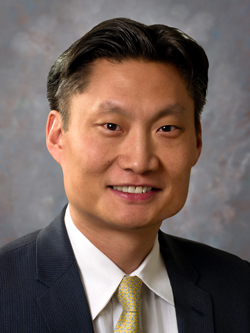
Dr. Paul Lee of the New York Eye and Ear Infirmary of Mount Sinai is the associate
program director of Mount Sinai's
Ophthalmology residency program in New York City.
|
“Why not me?” After the terrorist attacks on September 11, 2001, many men and women asked themselves this question as they considered joining the military to help defend our nation overseas from terrorist groups and terrorist nations. This same question “why not me? is also the same question many physicians asked themselves when facing the COVID pandemic.
When deciding upon medicine as a career, many of us consider the remote possibility that our profession may put our own lives in danger, but that possibility seems so remote and so far-fetched. Many of us confidently enter medical school with the assurance that the physician will have always have the upper hand in risk management in the patient-physician relationship, not only because we hold the knowledge and expertise but also because we are not the ones who are sick, our patients are.
For those of us who are even more risk adverse and want to minimize contacts with patients, we can choose fields such as pathology or radiology where patient contact is minimal. For those of us who enjoy working closely with patients but prefer to manage conditions which are not life-threatening or acute, we can choose fields like dermatology or ophthalmology.
COVID-19 changed everything. It is the first disease in my 20-year medical career, where physicians genuinely feared that they may be putting their own lives at risk by treating patients with the disease. Many of my colleagues did not want to go near a patient with the disease in fear of catching it themselves. I know of some colleagues who claimed that they had symptoms and stayed home for several weeks and even longer. I have never witnessed anything like the COVID pandemic in its challenge to all physicians to consider their calling to help and heal all patients, not just patients we are comfortable treating.
| | All across the U.S., schools and colleges of optometry, as well as associations such as The American Optometric Student Association (AOSA) and VOSH are stepping up to make contributions to the fight against COVID-19. We'd love to know what optometry students and schools are doing during this unprecedented time, so tell us your story at vmedit@jobson.com. |
As an ophthalmologist, my ability to help treat COVID-19 patients is limited but I am much better equipped to help treat them than a non-medical professional. Many of us choose ophthalmology because we prefer to work in outpatient settings, not emergency rooms, medical floors or ICUs. Several of my ophthalmology colleagues were reassigned to the floors to help treat COVID patients. I applaud them for their service.
As Chief of Ophthalmology at the James J. Peters VA Medical Center in the Bronx, N.Y. and Associate Program Director of Ophthalmology at the Icahn School of Medicine at Mount Sinai, I have been training ophthalmologists for 16 years and have trained over 60 ophthalmologists in my career. As the crisis hit our city hard in early March and our system was being strained, my residents stood up and volunteered to go to the frontlines of the COVID battle, which initially, was utterly baffling to me, but amazing and ultimately inspiring to me later. They renewed my call to be a doctor who takes care of all patients, despite the risk to me and potentially to my family. I have never been prouder of my trainees in my entire teaching career. Their story is a remarkable one and worth sharing.
On the evening of March 14, New York City went into lockdown mode. All non-essential businesses were mandated to close. All non-essential medical services were also suspended. COVID-19 ravaged the city more quickly than any of us anticipated. Shortly after the lockdown, emergency departments started filling up rapidly. Health care resources in the emergency departments, ICU’s and medical floors were rapidly being depleted. Shortage of PPE was another major concern. The number of patients dying from the disease increased daily. The entire world focused on the city as we were getting pummeled by this infection. Many of us stayed at home not only because we were ordered to but because we were scared.
On March 25, The New York Times published a report about the extremely high number of deaths in a single day at Elmhurst Hospital in Queens (Elmhurst Hospital Center is a teaching hospital of the Mount Sinai Health Care System). Photos showed patients lining up outside of the Elmhurst emergency department (ED), short of breath and coughing. Elmhurst ED needed more doctors to volunteer to help manage the extraordinary numbers of patients needing treatment for COVID-19.
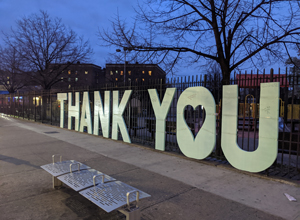
This Thank You sign at the entrance of Elmhurst Hospital was made by an artist to acknowledge health care workers for their heroic efforts in
fighting the coronavirus.
|
The Chairs of the Departments of Medicine and Emergency Medicine at the Icahn School of Medicine at Mount Sinai sent an email to fellow Chairs of departments throughout the system, asking for residents to volunteer to be redeployed to areas which needed help. Hours after Dr. Douglas Fredrick, Deputy Chair of Education of Mount Sinai Ophthalmology, asked residents to volunteer to be redeployed, six out of twelve residents raised their hands. Two of them were deployed to the Elmhurst ED and three of them were deployed to Mount Sinai medical floors. One had to stay home because her family member was sick.
It is one thing to be told to go somewhere, which many health care systems did with their faculty and trainees. It is another level of commitment, service, and bravery, to raise your hand and volunteer to go to the very frontlines of the most deadly and frightening pandemic our generation has witnessed.
Colin Anderson and Sarah Avila, PGY-4s, worked in the Elmhurst ED. Cesar Alfaro, Kirolos Ibrahim and Ethan Sobol, PGY-3s, worked on the medical floors at Mount Sinai Hospital. I have received permission from all of them to share their stories and photos.
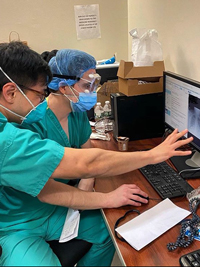 |
| 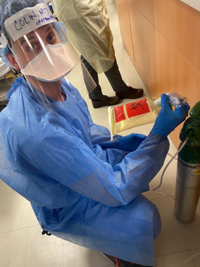 |
| 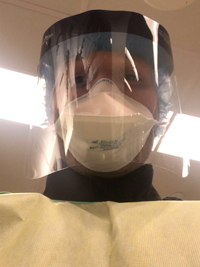 | | Ethan Sobol, MD, reviewing a chest x-ray. |
| Colin Anderson, MD, wearing a non-rebreather mask. |
| Kirolos Ibrahim, MD, in PPE |
Knowing the high level of risk in working in Elmhurst ED and Mount Sinai floors, why did you choose to volunteer there?
Ethan: “With our colleagues on the frontlines, I knew it was the right thing to do to pitch in and help share the burden.”
Cesar: “A lot of my colleagues from other programs were already on the frontlines risking exposure every day while we had less work than ever before. I felt that it was my duty to help if I had the time and ability to and I felt confident in being able to draw upon my intern year.”
Kirolos: “I felt that it was my duty, not only as a physician, but also as a human being to help out during this dire crisis.”
Sarah: “I volunteered for Elmhurst Hospital because it was the hospital that most needed our help. Over the last three years of training, I’ve grown to love Elmhurst Hospital for its humility and genuinely kind patients and staff.”
Colin: “Elmhurst is a very special place and patient relationships you develop here are very rewarding. By the time you are rotating during your third year, you feel a very strong connection to the community and the people. When I saw the reports about what the neighborhood was going through, my heart was broken. When we were given the opportunity to help, it was a very easy choice.”
How did your friends and family react when you told them that you were going to volunteer? Were they supportive? Where they obstructive?
All the residents shared that they received tremendous support from their family, despite some concerns about their safety.
Ethan: “Strangers have stopped me on the street while wearing scrubs, simply to say thank you to me. This has been very inspiring and motivational.”
Sarah: “My friends sent me flowers, care packages and numerous gifts through the mail that I never imagined I would receive.”
What was your most discouraging experience/event/incidence during your volunteer time?
Ethan, Cesar and Kirolos all took care of patients on the floors who died due to COVID and were the first people to share that terrible news with their family members. Colin and Sarah were working hard in the ED during the peak when oxygen requirements were the highest priority. The situation in Elmhurst ED has improved dramatically since then.
Sarah: “During the peak, many people died. I recall taking a break and questioning if my efforts were even making a difference. I spent hours of the day exchanging empty oxygen tanks and fighting for more supplies. I made sure patients were eating and drinking so they could stay strong. But no matter what I did, the next morning I was sure to open a chart of what was now a deceased patient. That crushed my heart.”
Is there a specific individual (patient, nurse, doctor, technician, etc.) who made a particularly positive impression on you?
Many residents formed new and lasting relationships with members of the team. The volunteer aspect of the teams automatically elevated the spirit of camaraderie and mutual understanding and respect. Some had patients who had remarkable turnarounds. A few of them pointed out unsung heroes.
Sarah: “There was a podiatrist who left her husband and children in Connecticut and drove every day to Elmhurst Hospital to volunteer in the ED. Her energy was amazing. It had been some time since she practiced general medicine, but her role was just as important as any doctor guiding care. She would sit down bedside and comfort a patient for hours. To me, she seemed like a mother figure and therapist for these patients. I couldn’t tell you how many times she was able to get a restless patient to finally sleep. They all felt better in her presence. It was amazing.”
Ethan: “Dr. Manan Shah, one of the supervising overnight hospitalists, left a strong impression on me. On one of my first nights, he assisted me in caring for a COVID patient whose condition had led to a whole host of complications and the beginnings of multi-organ failure. I was impressed by his calm and confident demeanor as he showed no hesitation in donning PPE and entering the patient’s room. As he talked to the patient, he held her hand and leaned in close with his face nearly touching hers in order to make out what she was saying over the loud hum of the high-flow nasal cannula and simultaneous non-rebreather that was covering the patient’s mouth. After seeing this, my resolve was stronger, and I felt confident that I could still provide personalized and humanistic patient care even under these circumstances.”
How do you think your volunteer experience will shape your career as an ophthalmologist?
All the residents developed a deeper appreciation for working in teams and for the vital roles that each member of a team plays. One of them reminded me that the physician who discovered the virus was an ophthalmologist. Tragically, he lost his life to COVID-19.
Ethan: “When Dr. Wenliang in China raised the alarms about this virus, he didn’t do so based on a clinical trial or an epidemiological study—he simply spoke out based on his clinical judgment and observations. He did what he thought was right. To me, this serves as a reminder that when the moment is right, we must trust our instincts and act.”
I asked them to share any other thoughts and comments and this one humbled me greatly.
Colin: “I feel like my contribution is ultimately a small one. Many doctors in other specialties are working longer hours and dealing with similar or worse conditions, day in and day out. There is no rotating in and then out for them, it is just their job until this pandemic is under control. We should do everything we can to pitch in when our colleagues and patients need it.”
(On a side note, when the Elmhurst ED was short on non-rebreather masks (NRB), Colin was able to invent more NRBs with a physician assistant by being creative with different parts of medical equipment. It worked and saved lives and many ED doctors have already asked and learned how to make it. Ophthalmologists can be versatile in many areas!)
On a lighter note, what are you looking forward to doing the most once this is over?
“Having a spicy margarita on a NYC rooftop bar!”
“Playing tennis.”
“Growing my beard back.”
“Seeing my family and friends.”
“Riding the subway to explore a new part of NYC.”
“Hugging my baby nephew.”
As many of us suspect, COVID-19 may change the world forever. As a father of three children ages 13, 10 and 8, I wonder what their future holds. Despite the uncertainty of the future, my residents’ valiant efforts reminded me that the human spirit will always be more resilient than any virus which will try to destroy us. We will always help those in need. We will risk our lives to do so. The journey is more important and rewarding than the result. We are in this together and we will prevail. Next time we face another pandemic, I will ask myself, “Why not me?”
|